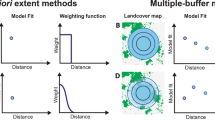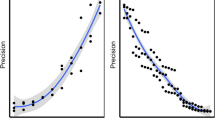Abstract
Biogeochemical models offer an important means of understanding carbon dynamics, but the computational complexity of many models means that modeling all grid cells on a large landscape is computationally burdensome. Because most biogeochemical models ignore adjacency effects between cells, however, a more efficient approach is possible. Recognizing that spatial variation in model outputs is solely a function of spatial variation in input driver variables such as climate, we developed a method to sample the model outputs in input variable space rather than geographic space, and to then use simple interpolation in input variable space to estimate values for the remainder of the landscape. We tested the method in a 100 km×260 km area of western Oregon, U.S.A. , comparing interpolated maps of net primary production (NPP) and net ecosystem production (NEP) with maps from an exhaustive, wall-to-wall run of the model. The interpolation method can match spatial patterns of model behavior well (correlations>0.8) using samples of only 5 t o 15% of the landscape. Compression of temporal variation in input drivers is a key step in the process, with choice of input variables for compression largely determining the upper bounds on the degree of match between interpolated and original maps. The method is applicable to any model that does not consider adjacency effects, and could free up computational expense for a variety of other computational burdens, including spatial sensitivity analyses, alternative scenario testing, or finer grain-size mapping.
Similar content being viewed by others
References
J.D. Aber C.A. Federer (1992) ArticleTitleA generalizedlumped-parameter model of photosynthesis, evapotranspiration and net primary production in temperate and boreal forest ecosystems Oecologia 92 463–474 Occurrence Handle10.1007/BF00317837
M.F. Acevedo S. Pamarti M. Ablan D. Urban A. Mikler (2001) ArticleTitleModeling forest landscapes: parameter estimation from gap models over heterogeneous terrain Simulation 77 53–68
G.A. Alexandrov T. Oikawa Y. Yamagata (2002) ArticleTitleThe scheme for globalization of a process-based model explaining gradations in terrestrial NPP and its application Ecol. Model. 148 293–306 Occurrence Handle10.1016/S0304-3800(01)00456-2
L.E. Band D.L. Peterson S.W. Running J. Coughlan R. Lammers J. Dungan R. Nemani (1991) ArticleTitleForest ecosystem processes at the watershed scale: basis for distributed simulation Ecol. Model. 56 171–196 Occurrence Handle10.1016/0304-3800(91)90199-B
G.E.P. Box N.R. Draper (1987) Empirical Model-Building and Response Surfaces John Wiley & Sons New York
I.C. Burke T.G.F. Kittel W.K. Lauenroth P. Snook C.M. Yonker W.J. Parton (1991) ArticleTitleRegional analysis of the central Great Plains BioScience 41 685–692
N.C. Coops R.H. Waring (2001) ArticleTitleEstimating forest productivity in the eastern Siskiyou Mountains of southwestern Oregon using a satellite driven process model, 3-PGS Can. J. For. Res. 31 143–154 Occurrence Handle10.1139/cjfr-31-1-143
S.E. Franklin (2001) Modeling forest net primary productivity with reduced uncertainty by remote sensing of cover type and leaf area index C.T. Hunsaker M.F. Goodchild M. Friedl T.J. Case (Eds) Spatial Uncertainty in Ecology: Implications for Remote Sensing and GIS Applications Springer-Verlag New York, NY 402
L.W. Friedman (1996) The Simulation Metamodel Kluwer Academic Publishers Norwell, Massachusetts
S.L. Garman (2004) ArticleTitleDesign and evaluation of a forest landscape change model for western Oregon Ecol. Model. 175 319–337 Occurrence Handle10.1016/j.ecolmodel.2003.10.015
R.H.G. Jongman C.J.F. ter Braak O.F.R. Tongeren Particlevan (1995) Data Analysis in Community and Landscape Ecology Cambridge University Press Cambridge
J.S. Kern D.P. Turner R.F. Dodson (1997) Spatial patterns in soil organic carbon pool size in the northwestern United States R. Lal J.M. Kimbal R. Follett B.A. Stewart (Eds) Soil Processes and the Carbon Cycle CRC Press Boca Raton 29–43
B.E. Law D.P. Turner M. Lefsky J. Campbell M. Guzy O. Sun S. Tuyl ParticleVan W.B. Cohen (2004) ArticleTitleDisturbance and climate effects on carbon stocks and fluxes across Western Oregon USA Global Change Biol. 10 1429–1444 Occurrence Handle10.1111/j.1365-2486.2004.00822.x
R.H. Myers D. Montgomery (2002) Response Surface Methodology: Process and Product Optimization using Designed Experiments John Wiley & Sons New York
S.V. Ollinger J.D. Aber C.A. Federer (1998) ArticleTitleEstimating regional forest productivity and water yield using an ecosystem model linked to a GIS Landscape Ecol. 13 323–334 Occurrence Handle10.1023/A:1008004423783
W.J. Parton J.W.B. Stewart C.V. Cole (1987) ArticleTitleAnalysis of factors controlling soil organic matter levels in Great Plains grasslands Soil Sci. Soc. Am. J. 51 1173–1179 Occurrence Handle1:CAS:528:DyaL2sXmtlGnsbw%3D
D.P. Peters J.E. Herrick D.L. Urban R.H. Gardner D.D. Breshears (2004) ArticleTitleStrategies for ecological extrapolation Oikos 106 627–636 Occurrence Handle10.1111/j.0030-1299.2004.12869.x
S.W. Running E.R.J. Hunt (1993) Generalization of a forest ecosystem process model for other biomes, BIOME-BGC, and an application for global-scale models C.B. Field J.R. Ehleringer (Eds) Scaling Ecophysiological Processes: Leaf to Globe Academic Press San Diego 388
Thornton P. 1998.Regional Ecosystem Simulation: Combining Surface- and Satellite-based Observations to Study Linkages between Terrestrial Energy and Mass Budgets. PhD Dissertation, University of Montana.
P. Thornton H. Hasenauer M.A. White (2000) ArticleTitleSimultaneous estimation of daily solar radiation and humidity from observed temperature and precipitation: an application over complex terrain in Austria Agric. For. Meteorol. 104 255–271 Occurrence Handle10.1016/S0168-1923(00)00170-2
P. Thornton S.W. Running M.A. White (1997) ArticleTitleGenerating surfaces of daily meteorological variables over large regions of complex terrain J. Hydrol. 190 214–251 Occurrence Handle10.1016/S0022-1694(96)03128-9
P.E. Thornton B.E. Law H.L. Gholz K.L. Clark E. Falge D.S. Ellsworth A.H. Goldstein R.K. Monson D. Hollinger M. Falk J. Chen J.P. Sparks (2002) ArticleTitleModeling and measuring the effects of disturbance history and climate on carbon and water budgets in evergreen needleleaf forests Agric. For. Meteorol. 113 185–222 Occurrence Handle10.1016/S0168-1923(02)00108-9
D. Urban M.F. Acevedo S.L. Garman (1999) Scaling fine-scale processes to large-scale patterns using models derived from models: meta-models D. Mladenoff W. Baker (Eds) Spatial Modeling of Forest Landscape Change: Approaches and Applications Cambridge University Press Cambridge 70–98
VEMAP Members 1995. Vegetation/ecosystem modeling and analysis project: Comparing biogeography and biogeochemistry models in a continental-scale study of terrestrial ecosystem responses to climate change and CO2 doubling. Global Biogeochem. Cycles 9: 407–437.
R.H. Waring J.F. Franklin (1979) ArticleTitleEvergreen coniferous forests of the Pacific Northwest Science 204 1380–1386
White M.A., Thornton P.E., Running S.W. and Nemani R.R. 2000. Parameterization and sensitivity analysis of the BIOME-BGC terrestrial ecosystem model: net primary production controls. Earth Interact. 4–003.
M. Williams E.B. Rastetter D.N. Fernandes M.L. Goulden G.R. Shaver L.C. Johnson (1997) ArticleTitlePredicting gross primary productivity in terrestrial ecosystems Ecol. Appl. 7 882–894
M. Williams E.B. Rastetter G.R. Shaver J.E. Hobbie E. Carpino B.L. Kwiatkowski (2001) ArticleTitlePrimary production of an arctic watershed: an uncertainty analysis Ecol. Appl. 11 1800–1816
Author information
Authors and Affiliations
Corresponding author
Rights and permissions
About this article
Cite this article
Kennedy, R.E., Turner, D.P., Cohen, W.B. et al. A Method to Efficiently Apply a Biogeochemical Model to a Landscape. Landscape Ecol 21, 213–224 (2006). https://doi.org/10.1007/s10980-005-0827-0
Received:
Accepted:
Issue Date:
DOI: https://doi.org/10.1007/s10980-005-0827-0




